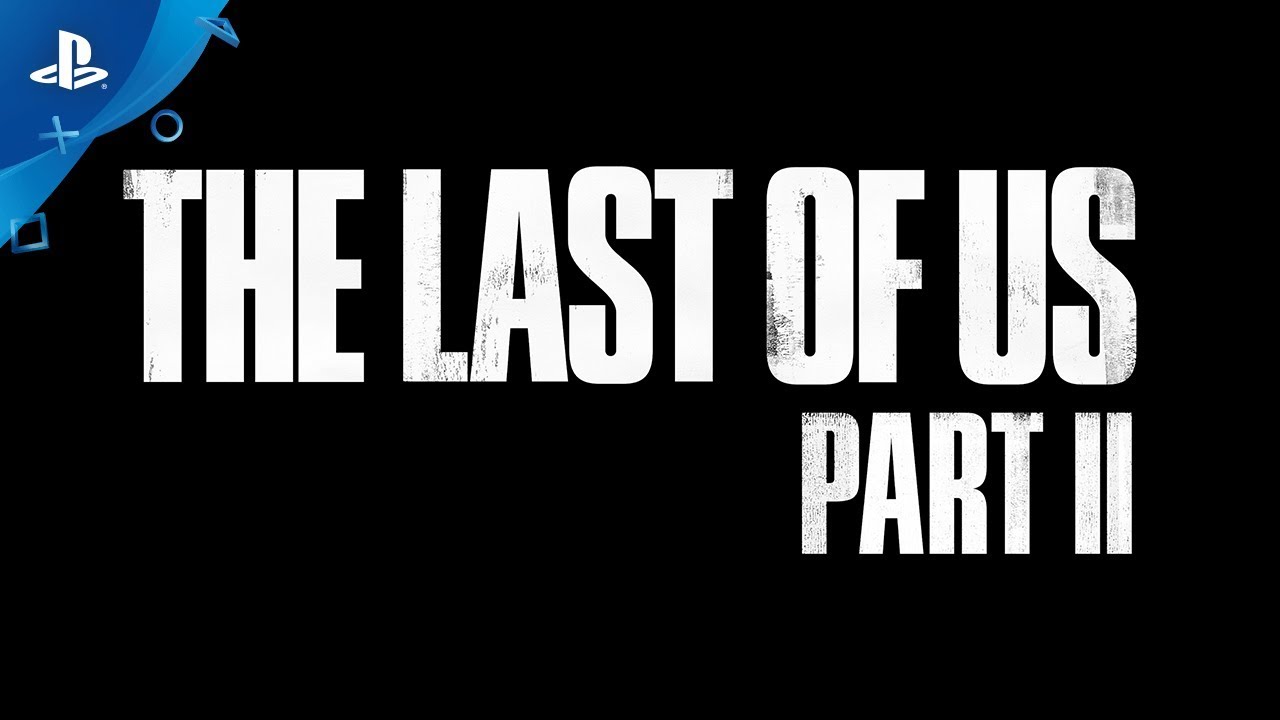In September of 2013, a fungal outbreak decimated the world and kickstarted the apocalypse. It transformed human beings into demons, which became known as Infected. These zombie-like creatures stalked, attacked, ate, and took control of the unlucky and unprepared who got in their way, and people became afraid of venturing out alone. Around this same time, a man named Joel attempted to flee his home in Texas and suffered an unimaginable loss in the process. This loss changed him, and made him a rougher version of himself.
Twenty years later, Joel met Ellie; a teenage girl who was in need of help. Together, the pair set out across the United States, in search of more stability and safety, as well as hope itself. This gripping, emotional and incredibly cinematic tale leads them into many precarious and dangerous situations, all of which require wits, intelligence and a mixture of stealth and combat to get around. In the end, it sets them on a path toward a group called the Fireflies, whose wish to create a cure for the infection may rest in Ellie herself, because she’s somehow proven to be immune to everything the fungus — and its many airborne spores — throw at her. Hell, she survived being bitten on the arm.
Such is the story of The Last of Us by Naughty Dog. A game that was so technically impressive and movie-like that it drew the attention of millions, many of whom seem to consider it as the best game of the last console generation. To be honest, I have a hard time arguing with those folks, although there sure were a lot of great games during the PlayStation 3/Xbox 360/Wii era.
It’s been a long wait, but after seven years we’ve received the much wanted and hotly anticipated sequel to one of the best games ever made. After lots of teases, numerous delays and pandemic related problems, The Last of Us: Part II is finally about to release. The wait may have been lengthy and somewhat difficult, but you can rest assured that it was worth it.
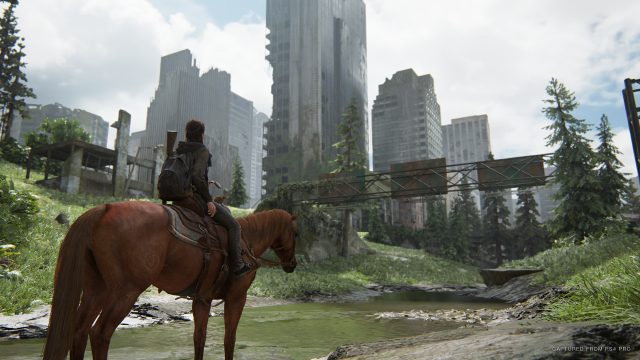
The story picks up five years after the events of the first game, when Joel made a questionable decision that affected many without being honest with his teenage ally. With help from others, such as his brother Tommy, the pair have built a new life for themselves in Jackson, Wyoming, where a flourishing town has been built and secured. Within its wooden gates and meager homes, the residents have developed a working society that is fueled by cooperation, including paired patrols. These horseback ventures keep the survivors safe and mindful, by tasking trained residents with checking nearby areas for hostiles. It’s all very regulated, and logbooks are even utilized to keep track of everything. When someone sees and/or kills an Infected, or maybe happens to rescue an ailing person, they write it down in the book before heading home.
It’s all been going well, and people are thriving. There’s some tension in the air, and between Joel and Ellie, but the reasoning becomes more clear as the game goes along. So, too, does the status of their relationship, which is told through beautiful flashbacks, of which The Last of Us: Part II has many.
After a patrol goes to hell, Ellie and company find themselves in yet another dangerous predicament, and it’s one that threatens everything she holds dear. This encounter with a group called the Wolves sets things in motion, and sets the tone for the rest of this lengthy game. Around the same time as it occurs, we’re introduced to Abby, a Wolf who plays a major role herein.
Following the above, our heroine sets out on a trip to Seattle, Washington, where she and (her girlfriend) Dina hope to discover the whereabouts of Abby and her comrades. Their goal? To right the scales by way of revenge, no matter how much of a toll it takes.
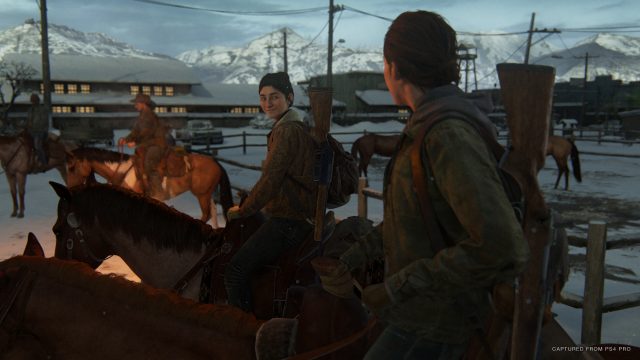
The majority of The Last of Us: Part II takes place in Seattle, which has been reclaimed by nature. What was once a bustling city of concrete and glass has since become overgrown and precarious. Buildings are crumbling, but a lot of the damage has come from underground, as water has broken roads and created streams, rapids and waterfalls in the process. It’s a beautiful but dangerous sight, not to mention dangerous.
For the next twenty-five hours, you’ll live with these characters and experience a story that will take a toll not just on them, but you as well. To say that this game is heavy would be to undersell it. It is, in fact, the most brutal and human thing I’ve ever played. Sure, lots of other games have been gory and violent, but none have been as realistic, brutal or unforgiving as this one. Of course realism is a big part of this as well, because we’re talking about a game that is so very visually impressive that it’s almost photo-realistic. Furthermore, it’s both impressive and jarring how this story can go from human and sweet to downright brutal within a minute. All of the above is a credit to the developers who have delivered something unprecedented.
Those who are familiar with the original game will have a good idea of what to expect from this sequel. That said, it turns things up to eleven. While the gameplay remains very similar, new mechanics, added realism and increased immersion qualities keep it fresh. So, too, does the semi-open world of Seattle, which allows for a decent amount of exploration. That said, this environment is contained and — while it feels big — is not as big as something found in a sandbox game. There’s a good amount to search through and find, but you can’t travel wherever you’d like on a whim. Many of the Seattle based chapters take the characters to new areas and locations, but there’s also some backtracking. Some buildings are open, some stores can be looted, and some locations have a lot to offer. Many are inaccessible, or limited in what they allow you to explore.
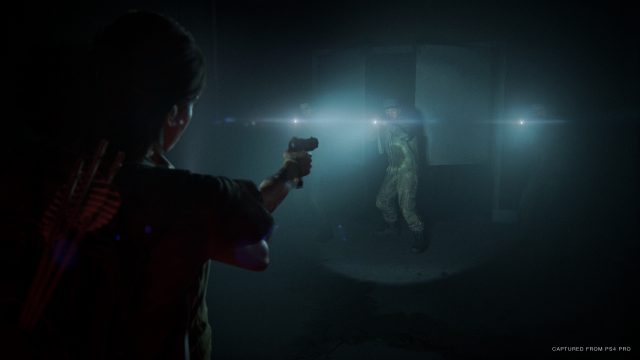
The core gameplay loop revolves around a mixture of stealth, climbing, exploration and combat, and you’ll want to pay close attention to the resources around you. In a post-apocalyptic world such as this supplies are limited, making carefully scouring each store, building and environment important. This is especially true in a game like The Last of Us: Part II, where crafting is such a big part of the experience and a requirement for survival. Supplies may be limited — and become even more scarce on higher difficulty — but they’re often the key difference between living and dying. This is because Ellie can craft many things, such as arrows, bullets, traps, smoke bombs, Molotov cocktails, incendiary shotgun rounds and all important medkits. The latter, which requires alcohol and paper to make, is the most important of all.
Later on more things will become available for creation. New recipes will be unlocked, new items will become available, and new combinations will be discovered. It’s all in how you use these things that defines how your play through will go. With so many things available for crafting, folks are given the opportunity to play as they prefer. Those who like stealth can do their best to get through encounters with Wolves, Infected and other enemies without being discovered, and will notice that fighting isn’t always necessary. Meanwhile, people who don’t enjoy being quiet and sneaking around can go in guns-a-blazin’ and utilize the many guns and other weapons at their disposal. Others can booby trap the environment and both confuse and kill enemies in the process. It’s all in how you decide to play.
For the most part, I attempted to be as stealthy as possible, because it felt like the smartest plan. After all, while The Last of Us and its sequel let you play as you wish, being quiet and taking your time tends to be the best way to go about it. Supplies are limited, health doesn’t regenerate, and enemies pack one hell of a punch, especially the blind clickers who use sound and echolocation to track you. If you startle one of these beasts you’ll have little time to take them out before they kill you in one swift bite. Those are plentiful, but they depict the third stage of infection. There are also many more basic ‘runners,’ who stumble around and only attack if they see you or become startled by noise. The key is to try to take out as many of these things in silence, by creeping up behind them, grabbing them from behind and either choking them or sticking a knife into their brains. This can be done with clickers, but you have to be very careful not to make a sound.
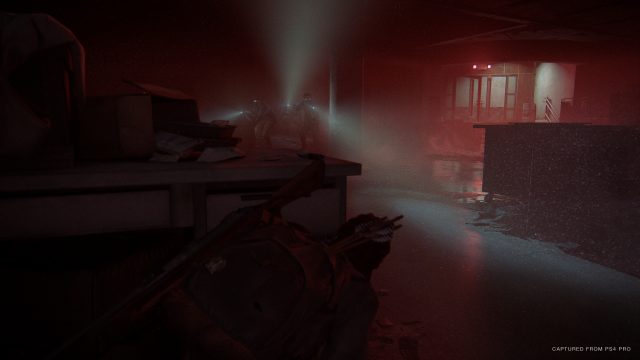
Of course, one could also make a silencer for their pistol and use headshots to do this dirty work, or use a bow and arrow. The thing is that supplies for both aren’t always readily available, and homemade silencers break after several shots. Then you’re forced to make a new one, which requires one of the med kit ingredients.
Thankfully, guns can also be upgraded independently, by finding work benches equipped with tools and either gas or electric lights. When you find one, you’ll be able to watch as Ellie adds to, cleans and improves the weapon you’ve chosen to make better, which is a neat and unexpected detail. Each part of your bullet based arsenal can be upgraded at least three times, if not five, with these improvements usually being things like added damage, reduced recoil, faster reloading and the ability to carry more ammunition. Parts are required for this process, and are limited like the stimulants that allow for character upgrades, so you’ll want to make sure that you’re happy with your choice before you confirm it.
Other types of Infected also play important roles in The Last of Us: Part II, and some present quite a challenge. The game shows us what happens when the mutation evolves, by eventually throwing massive, hulking beasts at us. These boomer-type creatures aren’t always that fast, but they can hit hard. They’re also able to throw gassy spores, which emit a green cloud of poison when they break. Hell, killing one is made even more dangerous by the fact that they explode upon death.
You’ll want to take special care when dealing with the big guys, but will more often than not find yourself with lesser types to dispatch of or avoid. Human enemies — who use the duck and cover approach, but will also often try to flank Ellie — are also quite common, and dealing with them is a bit of a different beast. Perhaps the most annoying enemy, though, happens to be the stalker type Infected who will attack in numbers. Often seen on all fours, they like to hide in dark, damp and derelict buildings, and will taunt you by making noise. Then, they’ll move around and try to attack you when you’re least expecting it, which sometimes forces Ellie into hand-to-hand combat with two or three. The goal is to take these things out as quickly as possible, because they’re deadly in groups.
Speaking of hand-to-hand combat, it’s important to highlight how much melee and fisticuffs play a role in The Last of Us: Part II. The simple truth of it all is that sometimes punching something (or someone) will be the only thing at your disposal. You’ll often have a weapon, though, and melee weapons are just as important as any gun. Well, they were during my play through.

Unlike guns, bows and the like, every melee weapon you pick up happens to be breakable. Of course these are mostly things like pipes, crowbars, boards and knives, though sledgehammers and large fire axes do become available after fights with larger (human) enemies. Some can be utilized as one hit kill weapons, and have the benefit of being quiet. Others require a few hits to dispatch enemies. Regardless, they’re incredibly helpful and kept me alive many times. Any time I could, I’d pick up and use one.
Through the game’s rather deep crafting menu, you’ll eventually be able to fix and improve your melee weapons at a cost of materials. This makes them slightly more durable and a bit more powerful, but whether or not doing so is worth it will depend on you. There are also quite a few of these weapons to find throughout the game world, which makes worrying about and investing materials into just one feel kind of foolish. Then again, I did do it with some of the heavier ones, because I loved having them for one hit kills.
Melee and hand-to-hand combat both utilize a system that places emphasis on dodging. By pressing the L1 button, players can move out of the way of incoming enemy attacks, and will have to do so up to three times in a row in some cases. Failure to evade will leave Ellie open to punishing blows, whereas doing so well will turn the tide and give the player an opening. Many of the fist fights — some of which are part of the story — are downright brutal, and so too are the stealth kills, finishing moves and death sequences you’ll see throughout the game. When Ellie is killed by man, beast or nature, the depictions of her death are as brutal and haunting as they are realistic looking.
Bricks and bottles can also help turn the tide of a battle. They can be used as distractions, and are sometimes required to break windows during environmental puzzles, but they’re also helpful combat tools. For instance, throwing one can stun an enemy and leave them open to a quick melee kill. Bricks are especially great for this, and the good thing is that they’re very plentiful. Granted, smashing windows is almost always a risk. It can alert enemies, and can draw them to one location, so smashing more than one at a time can be a good tactic. That said, Ellie continues to have a special advantage in that she can ‘listen’ for foes. Pressing R1 turns the world dark and highlights any nearby opponent — be they human or monster, or even a scent tracking dog of which there are quite a few — in white. This allows you to track and plan, and makes being stealthy easier.
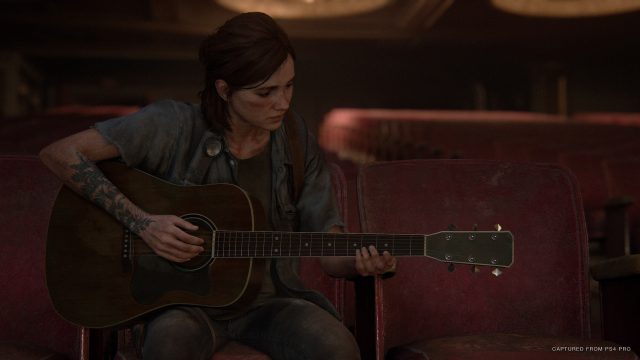
I don’t remember dogs being part of the first game. They’re a smart but annoying addition here, and I say that because they do their job pretty well. Sometimes human enemies will have dogs with them, or will even send one out. Said pooches will track and follow your scent if you move, or will alert to your presence if they run into you. They also pack one hell of a bite, but that’s to be expected. The nice thing is that ‘listening’ allows you to see your scent and the trail you’ve made, allowing for some deception. If you move around in circles or stay still it’s a good way to either confuse or avoid the dogs.
Almost all of Ellie’s abilities, such as stealth, listening, crafting and general movement, can be upgraded by picking up stimulants. It usually takes between thirty and fifty of them to unlock one upgrade, each of which are spread out over several different trees, with each one focusing on a certain type of skill. You may not get to take advantage of them all if you’re not careful and don’t take your time to explore. Reason being is that skill trees can only be unlocked by finding different magazines. One magazine may be sitting on a store’s counter in downtown Seattle, while another may be locked in one of the game’s safes. There are quite a few of those spread throughout the game world, and their combinations are often hinted at (or downright given away) in notes and other such correspondence. There are many such handwritten notes and flyers to find, and they give you a good idea of what other survivors are dealing with. On top of that, they let you know about the mindset of the Wolves and the second gang you’ll come across. They call themselves the Seraphites, but others call them Scars because they cut their faces. All of them worship one particular woman, as if she’s a type of religious figure, and they swear off electricity in the process. Most Scars live on a particular island, but a broken truce has resulted in them expanding into Seattle. Be wary of their whistling, their deadly (and health sucking) arrows and their stealth.
While the A.I. is quite good, it’s not perfect. You can usually get around or behind enemies by hiding and crawling in tall grass, and should really use it to your advantage whenever possible. It helps that weapons can be used while prone, as it makes silent kills easier.
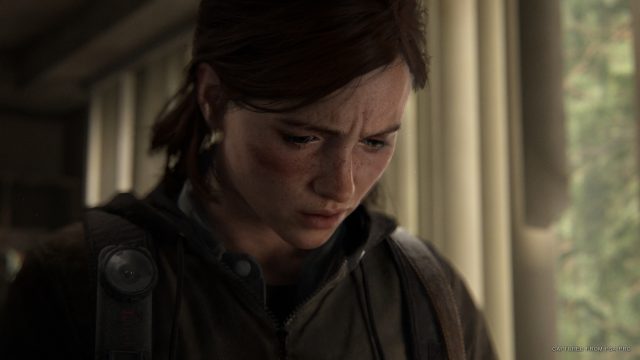
There are also times where you’ll find yourself in the middle of a gunfight between the Wolves and the Scars, and it’s this war between the two that acts as the backdrop of The Last of Us: Part II‘s story. It actually plays a rather large role, especially during the second half of the game.
When it comes to traversal throughout the world, you’ll mostly find yourself looking for climbing routes in and out of buildings. Oftentimes the front doors are locked, and the only way in may be from a collapsed roof or something similar. You’ll also explore most of the city on foot, although some parts will allow for horse or even boat travel. Ellie eventually finds a small fishing boat with a low powered motor, which helps her get past rapids and into certain areas.
This is a very immersive game, and it can be easy to get lost in just exploring the world around you. I took my time, did everything I could and tried to find as many of the items, crafting materials and collectibles I could, not to mention as much ammo as possible since it’s often pretty limited. This included the hidden superhero cards and state coins, both of which combine with notes and flyers to act as what we generally call collectibles. The game keeps track of how many you’ve found in its save menu, but you can look at them all by opening Ellie’s journal menu. This is done by using the touch pad; an input that is also used as to play the guitar, which is possible at certain points during the campaign.
With all that having been said, most of the people who enjoyed The Last of Us should enjoy Part II because it builds on its predecessor and is another technical marvel. It’s a sight to behold, and is something that will wow you as you play it. That said, this isn’t a perfect game.
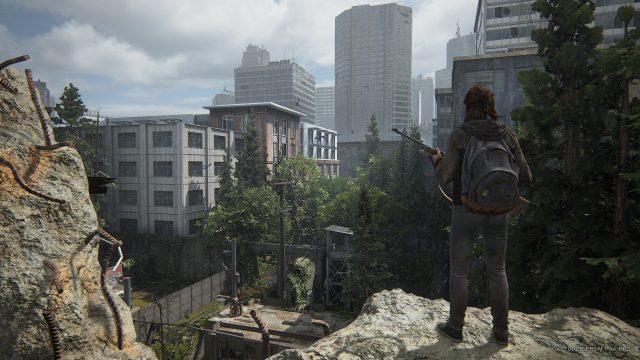
The writers did a really good job of developing characters — both ‘good’ and ‘bad’ — who feel human and relatable, and also deserve a lot of credit for showing them at their best and their worst. The flashbacks really humanize certain ones, and there’s a lot of heart to be found in certain relationships within, such as Joel and Ellie and Ellie and Dina. This allows for great impact when someone dies or does something heinous. However, the downside is that the game suffers from some pacing issues. This is partially due to how the first and second half are designed, but it’s also because of all of the flashbacks. The pacing isn’t bad, but it drags a little bit here and there and mars the game slightly.
As is the case with a lot of games, things can also become a bit repetitive. It happens here, but it’s not a big deal. The gameplay is fun, immersive, interesting and thought provoking, but the real star of the show is the story. The immersive stuff is still very good, but if you don’t particularly like Naughty Dog games or stealthy third-person shooters you may not be a big fan of this.
The Last of Us: Part II will also be too dark for some. It goes into such brutal, scary and downright shocking subject matter that some will be turned off. Its writers also didn’t shy away from infusing some personal politics into the mix, but I don’t think that should prevent anyone from playing what is a really good game. It’s mostly just equality based, and there’s nothing wrong with that.
Upon starting this game I wasn’t sure of what to expect length-wise. Developer estimates had been between 20 and 30 hours, but sometimes the people who make these games tend to over-exaggerate the amount of content they offer for sales purposes. Naughty Dog did not do this, at least in my experience. By the end I’d put approximately 25 hours into this game, according to my save file. That also didn’t count deaths, checkpoint reloads or other such things, and I died some. This isn’t an easy game, even on moderate, and I’ll never lie and say that I was great at it or beat it without dying. Some of the fights get pretty intense, and certain enemies can kill you with one bite.
What impressed me most about this thing was how downright gorgeous it looked. I’ve never played a better looking video game than this, and that’s saying a lot. The character models look incredible, their facial animations are utterly fantastic and all of the main characters feel like real people because they’re so well crafted and presented. The game world is also stunning, thanks to what is perhaps the best lighting and environmental effects system I’ve ever seen. Even though my TV is only 1080p, my jaw was on the floor quite often. I can only imagine how great everything looks in 4K.

Sometimes games that look close to this good suffer from technical problems. The Last of Us: Part II doesn’t, at least for the most part. Most of my twenty-five hours with this game were nearly flawless, without any sort of issue. I ended up encountering a few minor bugs during the second half, but they mostly boiled down to a texture glitch in the corner of a restaurant or something else that small. The only notable ‘glitch’ I really had involved one of the collectible quarters not loading, and the loading wheel spinning continuously. That was easily fixed by reloading the last checkpoint.
Most of my playthrough was completed with the game’s first patch installed, at it downloaded alongside the campaign itself. I later downloaded its second patch, which was installed during my last five or so hours. More patches are coming, but this isn’t something that needs a lot of work. It’s very, very polished.
It probably goes without saying now given all of the above, but The Last of Us: Part II was definitely worth the wait. We may have been forced to spend seven years wishing for it, but it’s finally here and lives up to the hype. While it’s not a perfect game, and may not set the world on fire like its predecessor did, it’s an incredibly immersive, unbelievably detailed and jaw-droppingly gorgeous experience, which also happens to have great sound design, top tier voice acting and very good writing. I’ve never played a better looking game, and what I experienced while playing it will definitely stick with me.
This review is based on the PlayStation 4 exclusive, which we were provided with. We reviewed it on a PS4 Pro console.

